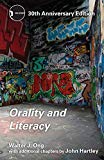Ed Simon at The Millions:
 However, it was an invention seven years earlier that restructured not just how language appears, but indeed the very rhythm of sentences; for, in 1496, Manutius introduced a novel bit of punctuation, a jaunty little man with leg splayed to the left as if he was pausing to hold open a door for the reader before they entered the next room, the odd mark at the caesura of this byzantine sentence that is known to posterity as the semicolon. Punctuation exists not in the wild; it is not a function of how we hear the word, but rather of how we write the Word. What the theorist Walter Ong described in his classic Orality and Literacy as being marks that are “even farther from the oral world than letters of the alphabet are: though part of a text they are unpronounceable, nonphonemic.” None of our notations are implied by mere speech, they are creatures of the page: comma, and semicolon; (as well as parenthesis and what Ben Jonson appropriately referred to as an “admiration,” but what we call an exclamation mark!)—the pregnant pause of a dash and the grim finality of a period. Has anything been left out? Oh, the ellipses…
However, it was an invention seven years earlier that restructured not just how language appears, but indeed the very rhythm of sentences; for, in 1496, Manutius introduced a novel bit of punctuation, a jaunty little man with leg splayed to the left as if he was pausing to hold open a door for the reader before they entered the next room, the odd mark at the caesura of this byzantine sentence that is known to posterity as the semicolon. Punctuation exists not in the wild; it is not a function of how we hear the word, but rather of how we write the Word. What the theorist Walter Ong described in his classic Orality and Literacy as being marks that are “even farther from the oral world than letters of the alphabet are: though part of a text they are unpronounceable, nonphonemic.” None of our notations are implied by mere speech, they are creatures of the page: comma, and semicolon; (as well as parenthesis and what Ben Jonson appropriately referred to as an “admiration,” but what we call an exclamation mark!)—the pregnant pause of a dash and the grim finality of a period. Has anything been left out? Oh, the ellipses…
more here.
